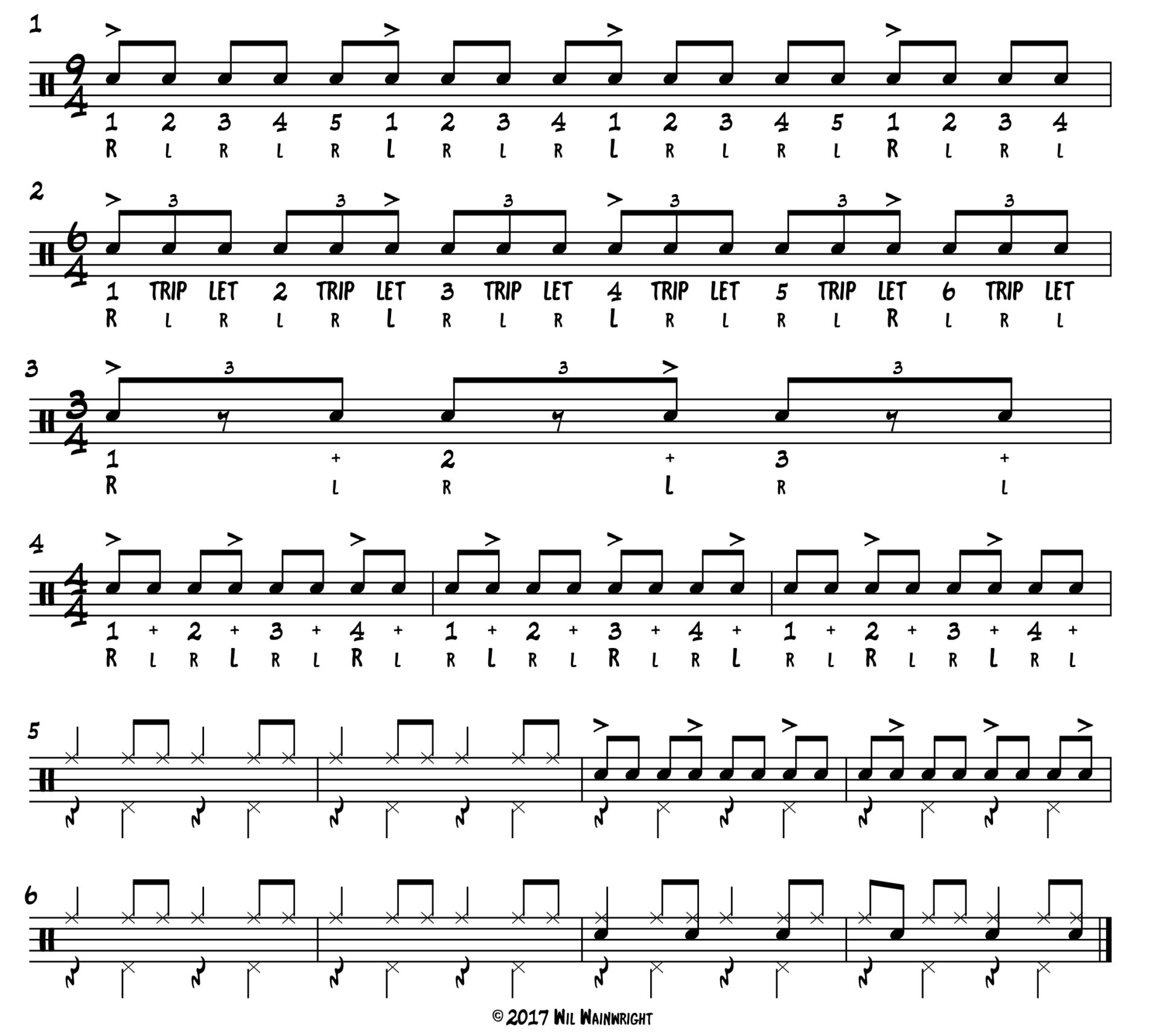Hello and welcome to the fifth instalment of the odd groupings series. In this lesson we will be looking at a slightly less obvious grouping of either 5 and 4 or 3 depending on how you feel or count it. When it comes to applying these patterns I have used a jazz approach but please do experiment and have some fun!
- In the first exercise we have a bar of straight 8th notes through 9/4, the notes are grouped into 5, 4, 5, 4. When you play through this, instead of using a standard count. I’d like you to count the groups (1,2,3,4,5,1,2,3,4). Once you have the pattern slowly, play along with a click making sure you play smoothy, dynamically and accurately. Then add in the left foot on a 1/4 note pulse.
- Number two would sound the same as number one if played out of context/without a click/not counting. Please do not just play it once and move on. It is really important to make sure you COUNT this bar accurately. It is in a different time signature and we are playing a different subdivision. When you play along with a click and incorporate the left foot you will feel the difference.
- Okay, so this is where this lesson gets a little more difficult to explain so bear with me. In this exercise we are playing the same accent pattern as in the previous exercise but we have removed the middle note from every triplet leaving us with swung 8th notes (still written as triplets). If we play this hand to hand, it resolves in 3/4 so it’s a little easier to count.
- Now to add to the confusion. The following exercises are written as 8th notes, please note that these should be played as SWUNG 8th notes (it’s a little more obvious when you look at 5 and 6 due to the jazz ride pattern). Please note that the accents are now in groups of three 8th notes. However, due to them being swung we can also think of them still in groups of 5 and 4. As you play this, keep your count as swung 8ths and as before add the left foot and practice this along to a click. As it’s a grouping of 3, it takes 3 bars to fully resolve.
- Application time. Here we have a really simple jazz time pattern for two bars and then the first two bars of our pattern. Obviously it doesn’t fully resolve in just two bars but that can make it quite a nice pattern. Please note that we are keeping the standard, 2 and 4, jazz left foot going through the pattern. At higher tempos, you might want to drop the last ride note from bar two to make the transition to the snare a little easier. Once you can comfortably play this, you should think about; adding bass drum feathering, orchestrating the pattern around the kit, taking the second and third or third and first bars from the previous exercise or even extending the pattern to 4 or more bars and finally adding other subdivisions such as 1/4 notes and full triplets. When you do this final stage, for now, keep the accents in the same place until you have fully assimilated this into your playing. You can spend MANY hours on number 5 as there is a lot of millage in this simple concept.
- With this final exercise, we have taken our accent pattern and used that rhythm as our left hand comping phrase. Personally, I find this popping up in my playing all the time as it sounds very musical and seems to flow nicely in many situations. As in the previous exercise please experiment with playing a different selection of bars from exercise 4. I really like using bars 2 and 3 as it sounds nice coming in on the up beat of one.
I hope you all got something out of that and find it useful for getting your hands warmed up. To start with it can be a little challenging, but once you have mastered it, you will be left with a quick and effective warm up. 

